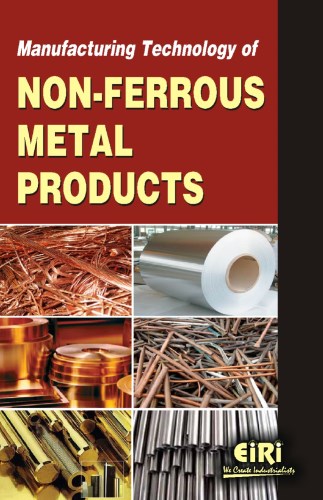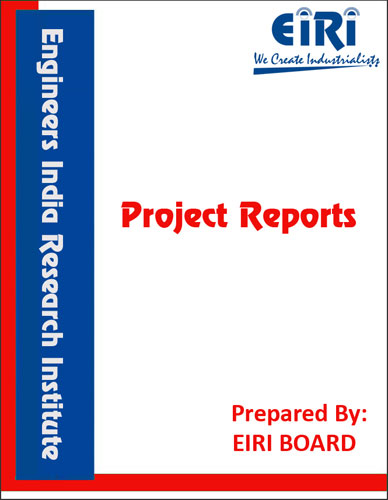Description
Contents-cum-Index
Introduction to Non-ferrous Metals
Manufacturing of Aluminium Products
- Properties of aluminium
- Uses and engineering applications of aluminium
- Manufacturing of aluminium can
- Background of Can
- Aluminium and aluminium products
- Raw materials
- Composition
- Capacity
- Dimensions
- Technical flow chart
- Machine udge and its purpose
- Horizontal impact extrusion press
- Trimming machine
- Cleaning machine
- Internal coating machine
- Accumulator
- Lacquer curing oven
- Base-coating machine
- Six-colour printing machine
- Fuel gas oven/platform
- Can capping machine
- Can latexing machine
- The manufacturing process
- Cutting the blank
- Redrawing the cup
- Trimming the ears
- Cleaning and decorating
- The lid
- Filling and seaming
- Bye-products/waste
- The future
Manufacturing Aluminium Pipe Standards of Aluminium
- Pipes
- Abstract
- Scope
- ASTM standards
- Specifications
- 6061- T 6 schedule 40
- Manufacturing process
- Pipe is manufactured by extrusion process
- Extrusion products
- Hot extrusion
- Cold extrusion
- Advantages
- Cold extrusion and cold forming
- Tube extrusion
- Extrusion equipment (Presses, dies and tools)
- Horizontal extrusion presses (15-50 MN capacity or up to 140 MN)
- Disadvantages
- Vertical extrusion presses (3-20 mn capacity)
- Requirements
- Die design
- Die materials
- Flat-faced dies
- Dies with conical entrance angle
- Remarks
- Typical arrangement of extrusion tooling
- Extrusion defects
Manufacturing of Aluminium Foil
- Introduction
- Characteristics and properties
- Chemical characteristics of aluminium foil
- Mechanical properties of aluminium foil
- Chemical formula of aluminium foil
- Types of aluminium foil
- Federal specification
- Requirements
- Chemical composition
- Surface finish
- Thickness and covering area
- Dimension tolerances
- Tolerances
- Width and length
- Raw materials
- Property
- Uses
- Packaging
- Insulation
- EMF shieling
- Cooking
- Art and decoration
- Geochemists sampling
- Polishing
- Quality control
- The future
- The manufacturing process
- Refining – Bayer process
- Smelting
- Rolling foil
- Finishing processes
Manufacturing of Aluminium Sheet
- Aluminium alloys grouped by major alloying elements
- Descriptions of Individual Aluminium Alloys
- 1100 Aluminium Sheet
- Typical Physical Properties of All Aluminium Alloys
- 2014 Aluminium Sheet
- 2024 Aluminium Sheet
- 2124 Aluminium Sheet
- 2219 Aluminium Sheet
- Hardening
- Applications
- 3003 Aluminium Sheet
- 3004 Aluminium Sheet
- 3005 Aluminium Sheet
- 3104 Aluminium Sheet
- 3105 Aluminium Sheet
- 5005 Aluminium Sheet
- 5052 Aluminium Sheet
- 5056 Aluminium Sheet
- 5083 Aluminium Sheet
- 5086 Aluminium Sheet
- 5182 Aluminium Sheet
- 5454 Aluminium Sheet
- 5456 Aluminium Sheet
- 6013 Aluminium Sheet
- 6061 Aluminium Sheet
- 7050 Aluminium Sheet
- 7075 Aluminium Sheet
- 7150 Aluminium Sheet
- 7475 Aluminium Sheet
- Grades of Aluminium sheets
- Standards of Aluminium Sheet
- Tolerances & Standards
- Sheet Tolerances EN 485-4
- Dimensional tolerances
- Width
- Length
- Shape tolerances
- Manufacturing Process
- The Production Process
- Plate, sheet and strip typical physical properties
- Aluminium Plate, Sheet and Strip: Typical Properties Products and Applications
Manufacturing of Aluminium Kettle
- Purposes
- Design
- Raw material
- Manufacturing process
- Quality Control
Manufacturing Process of Aluminium Products
- Casting Process of Aluminium
- Melting Details
- Crucibles Electric furnaces
- Casting processes
- Sand Casting
- Casting in metal moulds
- Centrifugal casting
- Shell moulding
- Investment casting
- Continuous casting
- Casting Defects
- Gas porosity
- Melt Temperature
- Other
- Forging of Aluminium Alloys – Process and Operation
- Forging Process
- Forging Operation
- Stock Preparation and Heating
- Die Heating
- Use of Die
- Lubricants
- Deduction of Residual Stresses
- Machining Process of Aluminium Products
- Electron Beam Welding
- Process of Aluminium Products
- Electron Beam Welding
- Operating Principle of an Electron Beam
- Welding Equipment
- Process Steps of the Deep Welding Process
- Electron Beam Welding of Butt Joints
- Terms Used for Describing a Weld
- Electron Beam Weldability of Aluminium Alloys
- Electron Beam Welds in Aluminium Alloys
- Rate of Vaporisation during Electron Beam Welding of 7050 (AlZnMgCu)
- Tensile Strength of Electron Beam Welded 7050 (AlZnMgCu)
- Laser Welding of Aluminium Products
- Laser Welding
- Principle of a Solid-State Laser
- Comparison between Electron Beam
- Welding and Laser Welding
- Laser Cutting of Aluminium Products
- Laser Cutting
- Principle of Laser Gas-Jet Cutting
- Laser Cutting Diagram for Aluminium
- Laser Beam Cutting of Aluminium
- Comparison of Laser Beam Cutting and Plasma Cutting
Heat Treatment of Aluminium Products
- Annealing
- Solution Heat Treatment
- Quenching
- Age Hardening
Forming and Bending Processes of Aluminium Products
Gauge
Rate of change in thickness vs gauge number
Bending Process of Aluminium
- Bending
- Types
- Air bending
- Bottoming
- Coining
- Three-point bending
- Folding
- Wiping
- Rotary bending
- Roll bending
- Elastomer bending
- Joggling
- Calculations
- Bend allowance
- Bend Deduction
- K-factor
- Curling
- Operation
- Decambering
- Processes
- Laser cutting Process of Aluminium
- Types
- Laser microjet
- Process
- Vaporization cutting
- Melt and blow
- Thermal stress cracking
- Stealth dicing of silicon wafers
- Reactive cutting
- Tolerances and surface finish
- Machine configurations
- Pulsing
- Advantages and disadvantages
Perforation of Aluminium Products Processes
- Die and punch
- Laser perforation
- Applications
- Stamping Process of Aluminium
- Stamping
- Operations
- Simulation
- Roll forming process of Aluminium
- Overview
- Process
- Geometric Possibilities
- Production Rates
- Other Considerations
- Ironing Process of Aluminium
- Punching Process of Aluminium
- Process
- Punching Characteristics
- Geometry
- Equipment
- Forces
- Spinning Process of Aluminium
- Process
- Tools
- Advantages & Disadvantages
- Water jet cutting of Aluminium Operation
- Benefits
- Versatility
- Availability
- Process
- Edge Quality
- Multi-axis cutting
Technology Innovation in Aluminium Products
- Introduction
- Direct-chill Casting
- Heat-treatable Alloys
- Two-piece Beverage Can
- Aluminium Extrusion
- Continuous Molten Metal Treatment
- Alloy 6061
- Electrical Conductors
- Continuous Casting
- Shape-casting Alloy A356
- Extrusion Press Quenching
Manufacturing of Copper Products
- Mechanical properties
- Refining of copper
- Types of copper
- Uses of copper
- ASTM specification codes for copper and copper alloys
- Indian standards course for practice
- Manufacturing of copper wire
- ASTM standards of copper wire
- Copper wire specification
- Copper wire manufacturing process
- Drawing process
- Annealing process
- Bunching/stranding process
- Tinning process – There are two process of tinning
- Braiding
- Process for tinsel wire
- Process of glass wire
- Manufacturing of copper pipe
- ASTM Standards
- Sizes – Copper pipe
- Temper
- DWV (drain waste vent)
- ACR (air conditioning and refrigeration)
- Distribution
- Raw material
- Melting
- Casting
- Piercing
- Extrusion
- Drawing
- Annealing
- Final steps
- Manufacturing of copper strips
- Types of beryllium copper strips
- ASTM: Standards
- Manufacturing process copper strips
- Feedstock pay-offs and straighteners
- Feed stock cleaning system
- Confirm machine
- Control system
- Product cooling system
- Quality control and measuring equipment
- Product handling system
- Tooling
- Manufacturing operations
- Product quality
- Economics
- Conclusion
- Manufacturing of Copper Foil
- Geometry
- Foil Patterning
- Heat Treatment
- Samples Fabricated and Tested
Material Characterization Techniques
- Determination of Sample Geometry
- Width
- Thickness
- Roughness
- Metallography
- X-Ray Diffraction
- Physical Principle
- Texture Goniometry
- Scanning Electron Microscope
- Physical Principle
- Contrast Methods
- Electron Backscatter Diffraction (EBSD)
- Measurement Setup Used
- Tensile Testing
- Setup
- Hardware
- Software
- Accuracy of LSM Algorithm
- Post Processing
- Material Model Optimization
Forging Process of Copper
- Forging Alloys
- Forging Temperature
- Forging Process and Equipment
- Operational Considerations
- Copper and Brass Forgings
- Introduction
- Unique Combinations of Properties
- Advantages of Copper and Brass Forgings
- High Strength
- Leak Resistance
- Close Tolerances
- Low Overall Cost
- The Hot Press Forging Process
- Rod Cutting
- Slug Heating
- Forging
- Trimming and Clipping
- Dip Finishing
- Packaging
- Dies and Die Design
- Die Design
- Draft
- Webs
- Construction
- Multiple Parts
- Design Changes
- Trimming or Clipping Dies
- Die Purchases
- Parting Line
- Holes and Cavities
- Forgings and Other
- Products – A Comparison
- Castings
- Screw Machine Products
- Stampings
- Machining
- Definition of a Forging
- TOLERANCES
- Inquiry or Purchase Order Information
- Heat Treating of Copper and Copper Alloys
- Homogenizing
- Annealing
- Stress Relieving
- Precipitation Hardening
- Extrusion Prosess of Copper
- Copper Profiles
- Copper Profile Shapes
- Advantages of Copper Extrusions
- Design of extruded copper profiles
- Do’s and Don’ts in Copper extruded Profile Design
- Manufacturing Copper Extruded Profiles
- Application of the Copper extruded profiles
Joining Process of Copper
- Introduction
- Selection of a Joining Process
- Bolting and Riveting
- Adhesive Bonding
- Soldering
- Recommended Solder Fluxes for Engineering Materials
- Soft Solder Filler Metals
- Resistance Soldering
- Brazing and Silver Soldering
- The Brazing Process
- Basic Principles
- Brazing Filler Metals
- Copper-Silver Alloys
- Copper-phosphorus silver alloys
- Joint Design
- Physical and Metallurgical Factors
- The Coppers
- Alloys Heavily Cold-worked, or with High Softening Temperatures
- Precipitation-hardening Copper Alloys
- Alloys Containing Aluminium
- Alloys Containing Lead
- Alloys Containing Tellurium or Sulphur
- The Bronze Welding Process
- Basic Principles
- Filler Metals
- Joint Design
- Welding
- Gas-shielded Arc Welding
- Shielding Gases
- TIG Welding
- MIG Welding
- Joint Design and Preparation
- Basic Steps in Joining Process
- Pre-weld and Inter-run Cleaning
- Jigging and Backing Techniques
- Preheating and Inter-run Temperatures
- Process Applications
- Work-hardening and Precipitation-hardening Copper-rich Alloys
- Electron Beam Welding
- Joint Design and Preparation
- Laser Welding
- Friction Welding
- Ultrasonic Welding
- Ball Bonding
- Wedge Bonding
- Joining and Repairing Castings
- Copper-based Casting Alloys
- General Principles, Joint Design and Preparation
- Selection of Welding Process and Welding Techniques
- Metallurgical Factors in Welding Castings
- Selection of Filler Metals
- Metallurgical Behaviour of Cast Alloys
- Joining Dissimilar Metals and Weld Surfacing
- Availability of Pre-clad Material
- Weld Surfacing
- Metallurgical Factors in Joining Dissimilar Metals
- Copper to Steel
- Copper Nickel to Steel
- Aluminium Bronzes to Steel
- Copper to Aluminium
- Copper and Alloys to Other Copper Alloys
Manufacturing of Lead Products
- Properties of lead
- Corroding lead
- Chemical lead
- Tellurium lead
- Antimonial lead
- Uses of lead
- Indian standard specification
- List of lead products
- Lead Products
- Lead-Acid Batteries
- Lead Sheet
- Lead Pipe
- Cable Sheathing
- Lead Cames
- Lead-Clad Steel
- Lead Powder
- Lead Alloys
- Lead for Radiation Shielding
- Lead in Glass
- Lead for Ceramics
- Lead Pigments
- Lead Wool
Manufacturing of Lead Acid Battery
- Specification for Battery Secondary, Lead Acid,
- Low Maintenance For Mt Purposes
- Foreword
- Scope
- Related Specifications
- Illustration and Drawings
- Terminology, Definitions & Symbols
- Battery
- Initial Charge
- Normal Charge
- Charging of battery
- Accelerated charge
- Over Charge
- Retention of Charge
- Rated Capacity
- Nominal Voltage
- Shelf Life/Storage Life
- High Rate Discharge Test
- Specific Gravity
- Water Consumption Test
- Materials, Construction and Workmanship
- Separator
- Sealing Material
- Terminals
- Electrolyte
- Construction
- Dimensions and Tolerance
- Workmanship and Finish
- Packing The Individual Battery
- Pre-inspection of Supplies By Supplier
- Quality Assurance
- Sampling Procedure
- Product Specification
- Details of tests to be carried out by the Supplier
- Classification Of Tests
- Acceptance Tests Details
- Equipment
- Voltmeter and Ammeter
- Thermometer
- Hydrometer
- Instrument for Measuring Length
- Methods of Test and Requirements
- Visual Examination
- Physical Examination
- Dimensions and Layout
- Marking
- Capacity (5-h rate)
- Temperature correction
- Requirement
- High Rate Discharge
- Requirement
- High Rate Discharge at Normal Temp
- Robustness of Handles
- Requirements for High Rate Discharge At
- Normal Temperature
- Charge Acceptance
- Requirement
- Air Pressure test
- Life Cycle Test
- Vibration Resistance
- Requirement
- Overcharge Endurance
- Requirement
- Strength of Terminal
- Requirement
- Robustness to Fastening
- Requirement
- Test for Dry-Charged Battery
- Requirement
- High Voltage Test
- Retention of charge Test
- Electrolyte retention Test
- Special Tests
- Reserve Capacity
- Cold Cranking Performance
- Water Consumption Test
- Environmental Tests (For Special Battery i,e. 12 V 20 AH)
- Contamination Test
- Dust Test
- Dry Heat Test
- Impact Strength
- Damp Heat Test
- Corrosion (Salt) Test
- Reliability of soldered areas
- Dry Storage Test (1 Year)
- Drop Test
- Tropical exposure Test
- Transit And Storage
- Receipt Inspection by the Consignee
- Stocking and Issue
- Warranty
- Control Sample
Types of Lead-Acid Batteries
- Engine Starting
- Motive Power
- Standby Power
- Valve-Regulated Lead-Acid Batteries
- Principle of Operation
- Absorbed Electrolyte
- Gelled Electrolyte
- Construction of Valve- Regulated Batteries
- The Advantages of Valve- Regulated Batteries
- The Limitations of Valve- Regulated Batteries
- Applications of Valve- Regulated Batteries
- Design
- Raw Materials
- The Manufacturing
- Process
- Quality Control
- Environmental Issues
- The Future
- Process of Lead Dioxide
- Properties
- Chemical
- Electrochemical
- Production
- Applications
- Safety
Production of Lead Oxide and Pigment
- General
- Process Description
- Emission and Control
Manufacturing of Lead Crystal
- Background
- History
- Raw Materials
- Design
- The Manufacturing Process
- Quality Control
- Byproducts/Waste
The book Manufacturing Technology of Non-Ferrous Metal Products covers Introduction to Non-Ferrous Metals, Manufacturing of Aluminium Products, Manufacturing Aluminium Pipe, Manufacturing of Aluminium Foil, Manufacturing of Aluminium Sheet, Manufacturing of Aluminium Kettle, Manufacturing Process of Aluminium Products, Heat Treatment of Aluminium Products, forming and Bending Processes of Aluminium Products, Bending Process of aluminium, Technology Innovation in aluminium Products, Manufacturing of Copper Products, Manufacturing of Copper Foil, Material Characterization Techniques, Forging Process of Copper, Joining Process of Copper, Manufacturing of Lead Products, Manufacturing of Lead Acid Battery, Types of Lead Acid Batteries, Production of Lead Oxide and Pigment, Manufacturing of Lead Crystal





